For smartphone photography enthusiasts, Sony’s latest flagship offering, the Xperia XZ, features a 23Mp 1/2.3”-type sensor (5520×4140 pixels)and a wide-angle 24mm-equivalent f/2 lens. Achieving an overall DxOMark Mobile score of 87 points, compared to 88 for its predecessor the Xperia X Performance, it shares many of the same strengths and weaknesses of Sony’s previous device.
The Sony XZ has a notably lower score for photo artifacts, however, which include some noticeable haloing, ringing, and over-sharpening, all of which impacted its overall score. Achieving a Photo sub-score of 87, the XZ’s strength lies in its excellent autofocus system, which is fast and accurate in all lighting conditions, and particularly impressive in bright light.
Target exposures are generally good, with pleasant color and accurate white balance, although dynamic range is limited in some exposures, and HDR sometimes fails to activate automatically. Exposures in extreme low light are impressive, though, and thanks to Sony’s stabilization system that detects camera movement and adjusts settings accordingly, some impressive detail with low levels of noise are possible when using a phone support in low light.
The Sony XZ achieves a higher Video sub-score of 88 points, recording moving images at either 2160p@30fps or 1080p@60/30fps (tested default mode is 1080p@30fps), and offering good stabilization and autofocus systems. Dynamic range is again a little limited in video exposures, with overexposed highlights, but exposure adaptation when changing lighting conditions is both quick and smooth.
Video color rendering and white balance are accurate, and although luminance noise is well-controlled in all lighting conditions, some chromatic or colored noise is evident in low-light movies.
Outdoors: Warm and very pleasant white balance
Outdoors or in bright light, the Sony XZ delivers many accurate target exposures with strong, vivid color and a generally warm, but very pleasant white balance.
However, when shooting high-contrast scenes, dynamic range is sometimes limited, with a noticeable loss of detail in both the shadow and highlight regions in some exposures. The XZ’s automatically-activated HDR mode doesn’t always kick in when required, so it’s worth persevering to make sure you get the exposure you want when shooting high-contrast scenes. The 23Mp sensor records images packed with good detail and texture, even in the down-sampled 8Mp images that the device captures in its default mode. Some fine details are lost in low-contrast areas, however, and coarse luminance noise is visible in the sky as well as in other areas of uniform color.
Indoors: Great detail with phone support
Shooting in low-light conditions, the Sony XZ recorded generally good target exposures, even in extreme low light. Good indoor exposures lead to pleasant color rendering, with bold and vivid hues present in many low-light shots. White balance is a little variable shooting under different indoor light color temperatures, however. A noticeable blue colorcast appears under fluorescent light, and a yellow colorcast under tungsten, with some color shading evident between the center and edges of the frame.
Details are well-preserved and noise is well-controlled on low-light images, however, especially if you can use some form of phone support. Giros used for the stabilization system can detect phone movement, which the XZ uses to determine exposure settings in low light. As a result, lower ISO sensitivities with slower shutter speeds improve the level of detail recorded in low-light images compared to many other devices. For example, shooting under a 20 Lux light source with a tripod produced sharper more detailed images, since the Sony XZ opted for a slower 1/8 sec exposure time and ISO 400 sensitivity, compared to 1/16 sec at ISO 800 when shooting handheld.
Details: Explaining the score
Exposure and Contrast (86)
Showing a solid score for exposure and contrast, the Sony XZ lost some points due to its limited dynamic range in some shots, as well as inconsistencies in HDR activation. Very good low-light exposures, even in extreme low light, nonetheless helped boost its score.
Color (86)
The Sony XZ puts in a good all-round performance for color, with strong and vivid rendering in all lighting conditions. Outdoors, white balance is on the warm side, but has a nice, pleasant feel; and colorcasts in indoor images vary between a slight blue under fluorescent light to yellow under tungsten, but color saturation remains strong.
Autofocus (95)
Achieving an outstanding score, the Sony XZ’s phase detection autofocus system is very fast and accurate in all conditions, but particularly impressive in bright light. In low light, we observed some minor instabilities, with its “touch-to-focus” mode slightly less consistent than auto mode — but we’re being picky and autofocus is generally impressive on the XZ.
Texture (89)
Noise (87)
Good edge preservation in bright light is a bonus, but the lower-resolution 8Mp images recorded in default mode lose some fine detail, particularly in low-contrast areas. Low-light details are very well-preserved, with very low levels of noise if you can use some kind of phone support; and although fine details are often lost in low-light images when shooting handheld, they’re still very acceptable.
Artifacts (70)
The Sony XZ achieved its lowest category score for artifacts, which affected its overall ranking. Strong ringing and halo effects around backlit objects and contrast edges are very visible in both general outdoor scenes, as well as in high dynamic range shots. There’s also a visible loss of sharpness between the center and the edges of the frame, together with noticeable over-sharpening of certain subjects. A close-to-saturation cyan shift of the hues in the sky, together with some noticeable flare shooting towards the light, as well as slight moiré and maze patterns in high-frequency areas are visible in many outdoor images.
Flash (85)
The Sony XZ’s LED unit delivers flash-only pictures with pleasant white balance and good color rendering, especially for skin tones. Detail preservation is also good using flash, particularly towards the center of the frame, but with some light attenuation, noise, and color irregularities towards the edges where the flash drops off. The XZ’s flash output is slightly off-center, with flash-only images noticeably brighter towards the top of the frame. Mixing flash with additional light sources, the white balance displays a slight pink colorcast, although colors remain pleasant; and we also observed some slight irregularities in focus and exposure when using flash.
Video (88)
The Sony XZ shoots video at 2160p@30fps or at 1080p@60/30fps, and features an excellent video stabilization system, which effectivly reduces camera shake in all lighting conditions.
Video exposures are generally very good, boasting smooth exposure adaptation as lighting conditions change. As with stills, dynamic range is a little limited, however, which is particularly noticable when shooting video in bright light, often resulting in overexposed highlights.
Fast and accurate autofocus is a strong point for video on the Sony XZ, with excellent focus correction during zooming, although slight inconsistencies are evident during scene changes, when the XZ sometimes drops focus. Color rendering is also good in all lighting conditions, with generally accurate white balance that boasts effective and smooth adaptation as light conditions change. We noted some minor white balance instabilities during panning or walking, as well as visible color shading shooting video in low light. Texture preservation on videos shot in bright light is good, with low levels of luminance noise. In low light, some fine details are lost and some slight chromatic noise is visible, but luminance noise is low in all conditions.
Photo Pros
- Generally good target exposures even in very low-light conditions.
- Fast and accurate autofocus in all lighting conditions, particularly in bright light.
- Very pleasant color rendering and white balance in bright light.
- Details are well-preserved and noise is low in low-light images.
- Pleasant white balance and color using flash with no additional light sources.
Video Pros
- Very good video stabilization in all lighting conditions.
- Fast and accurate autofocus in all lighting conditions.
- Good overall exposure, with smooth exposure convergence.
- Good color rendering and white balance.
- Low level of luminance noise.
Photo Cons
- Halos, ringing, moiré and other artifacts visible in images shot in bright light.
- Loss of sharpness in the corners of the image compared to the center.
- Details are lost in low-contrast areas, with coarse luminance noise visible.
- In high-contrast scenes, details are lost in both highlight and shadow regions.
Video Cons
- Noticeable micro-vibrations during video capture on a tripod.
- Residual motion blur visible in videos shot in all lighting conditions.
- Color shading visible in low-light conditions.
- Slight buildup of chromatic noise visible in low-light conditions.








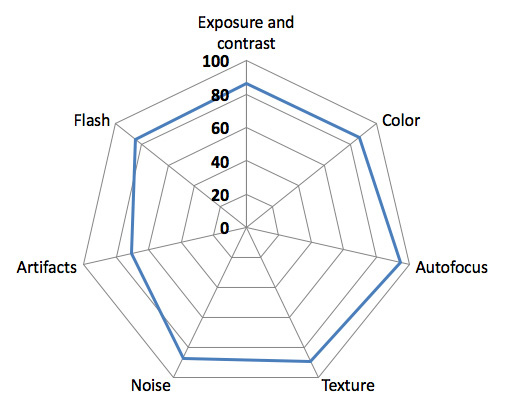

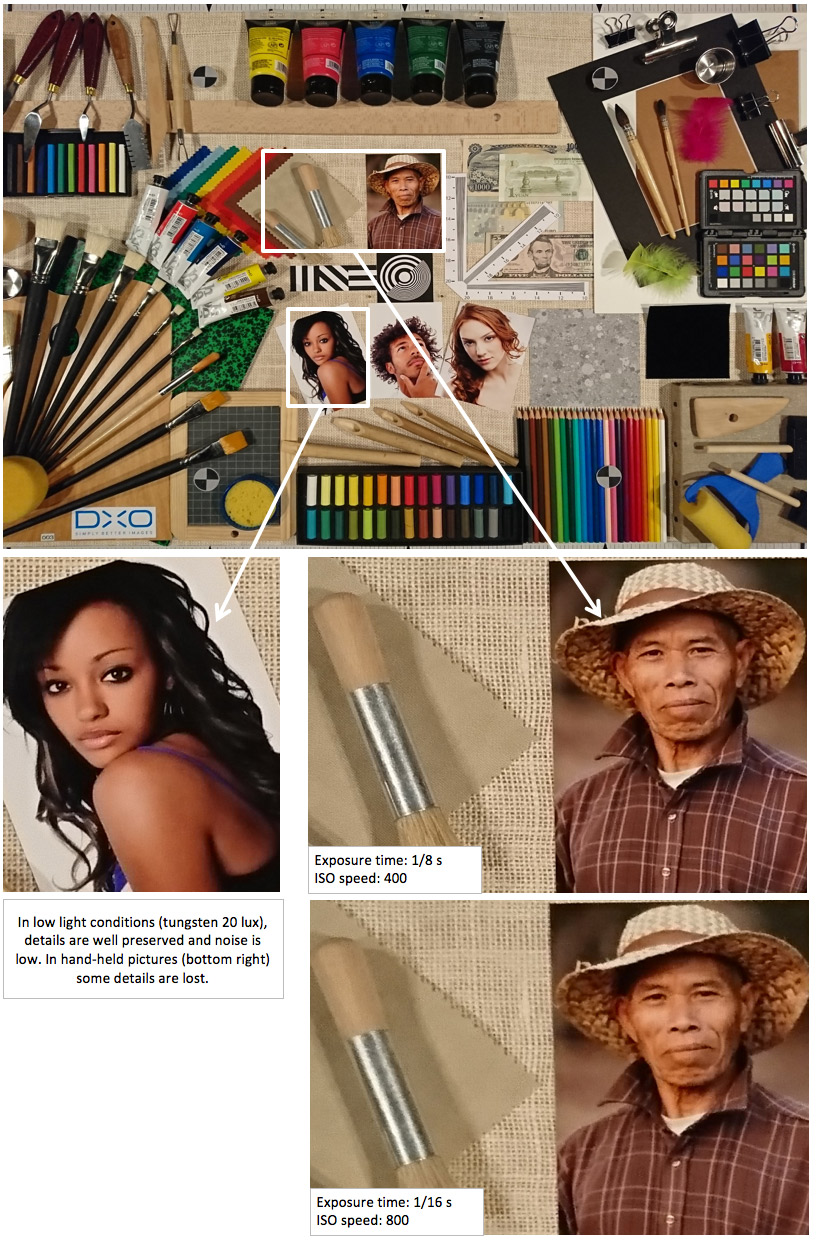
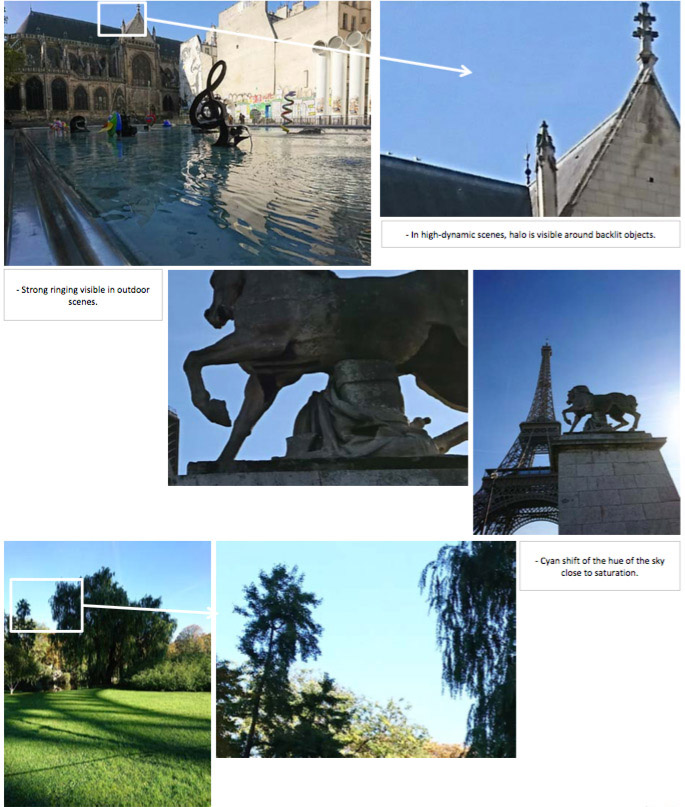
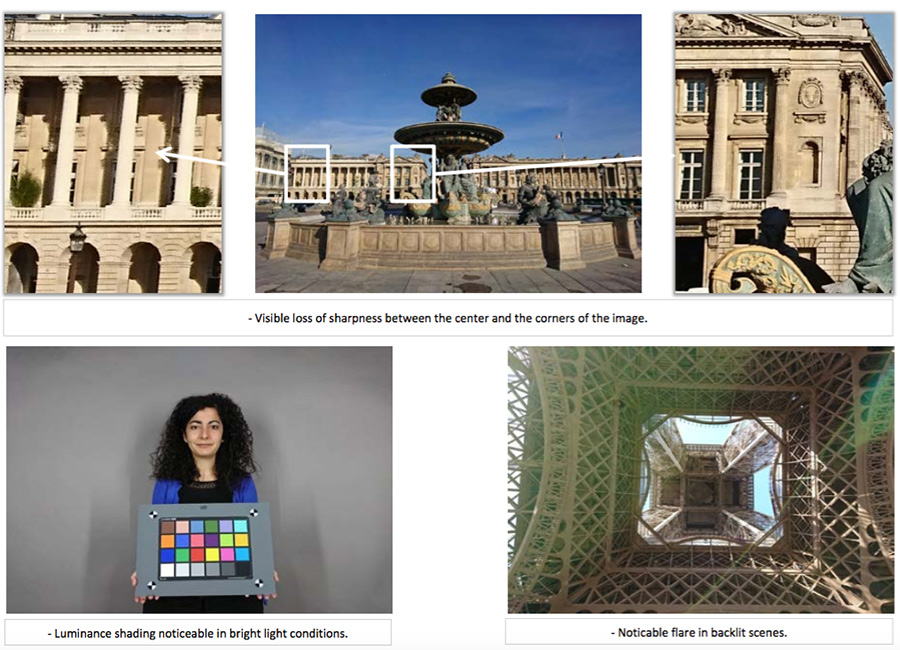

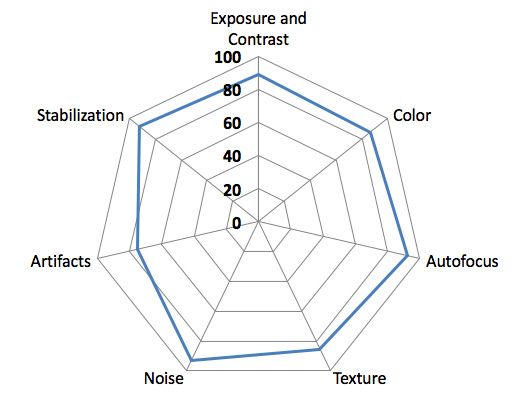
DXOMARK encourages its readers to share comments on the articles. To read or post comments, Disqus cookies are required. Change your Cookies Preferences and read more about our Comment Policy.